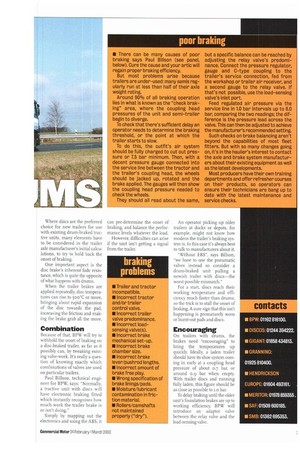a balancin act
Page 38

Page 39

If you've noticed an error in this article please click here to report it so we can fix it.
Achieving quick, efficient braking with drum-braked tractive units and semi-trailers has always been a bit of a balancing act. Now, with disc brakes becoming common, how do you ensure compatibility between the two? Chfhas been looking for some answers.
aintaining braking compatibility between a tractive unit and semitrailer is as
vital today as it ever was, especially with the growing use of disc brakes on either or both elements of the artic. It's all a question of getting a balanced performance between the two to achieve good, efficient braking.
Increasingly, new artic combinations are being equipped with discs but what about hauliers with brand new disc-braked units and drums on their trailers, or conversely, those with older drum-braked tractors working with the very latest semis? How can operators be satisfied that they'll still be within reach of that holy grail, braking compatibility?
If you're about to invest in new disc-braked trailers it's always useful to consult with the axle manufacturer first, to determine the actual size of brake that is needed.
BPW, for example, has two sizes of brake disc: 370 mm diameter for axles up to 9.0 tonnes and using 19.5in or 2 z.5in tyre equipment; plus a 43omm disc for ro/12-tonne operations running on 22.51n wheels.
With all-drum brakes, a tandern-axled artic pulling a triaxle trailer should share the braking effort in a 40/60 ratio, while the brakes on a 3+3 outfit ought to be working 50/50.
Many drivers like to feel the braking force of the trailer and are comfortable with the directional stability that this promises. However, it disguises the fact that the trailer may be doing too much, the clue being accelerated lining wear at the rear rather than on the tractive unit.
It's a real cocktail of circumstance through which producers like BPW have to plot a course. Where discs are the preferred choice for new trailers for use with existing drum-braked tractive units, many elements have to be considered in the trailer axle manufacturer's initial calculations, to try to hold back the onset of braking.
One important aspect is the disc brake's inherent fade resistance, which is quite the opposite of what happens with drums.
When the trailer brakes are applied repeatedly, disc temperatures can rise to 500"C or more, bringing about rapid expansion of the disc towards the pad, increasing the friction and making the brake grab all the more.
Combination
Because of that, BPW will try to withhold the onset of braking on a disc-braked trailer, as far as it possibly can, by tweaking existing valve-work. It's really a question of knowing exactly which combinations of valves are 'iced on particular trailers.
Paul Billson, technical engineer for BPW, says: "Normally, a tractive unit with discs will have electronic braking fitted which instantly recognises how much work the trailer brake is or isn't doing."
Simply by mapping out the electronics and using the ABS, it can pre-determine the onset of braking, and balance the performance levels whatever the load.
However, difficulties can arise if the unit isn't getting a signal from the trailer. An operator picking up older trailers at docks or depots, for example, might not know how modern the trailer's braking system is. In this case it's always best to talk to manufacturers about it.
"Without EBS", says Billson, "we have to use the pneumatic valves instead so consider a drum-braked unit pulling a newish trailer with discs—the worst possible mismatch."
For a start, discs reach their working temperature and efficiency much faster than drums, so the trick is to stall the onset of braking. A sure sign that this isn't happening is prematurely worn or burnt-out pads and discs.
Encouraging
On trailers %N.-ith drums, the brakes need "encouraging" to bring the temperatures up quickly. Ideally, a laden trailer should have its shoe system coming in early at a coupling head pressure of about o.7 bar, or around 0.9 bar when empty. With trailer discs and running fully laden, this figure should be as close as possible to i.o bar.
To delay braking until the older unit's foundation brakes are up to working efficiency, BPW will introduce an adaptor valve between the relay valve and the load-sensing valve.












































































































